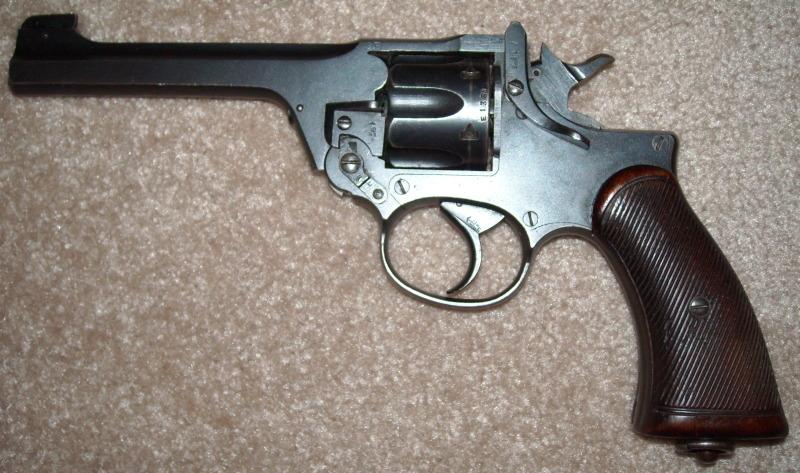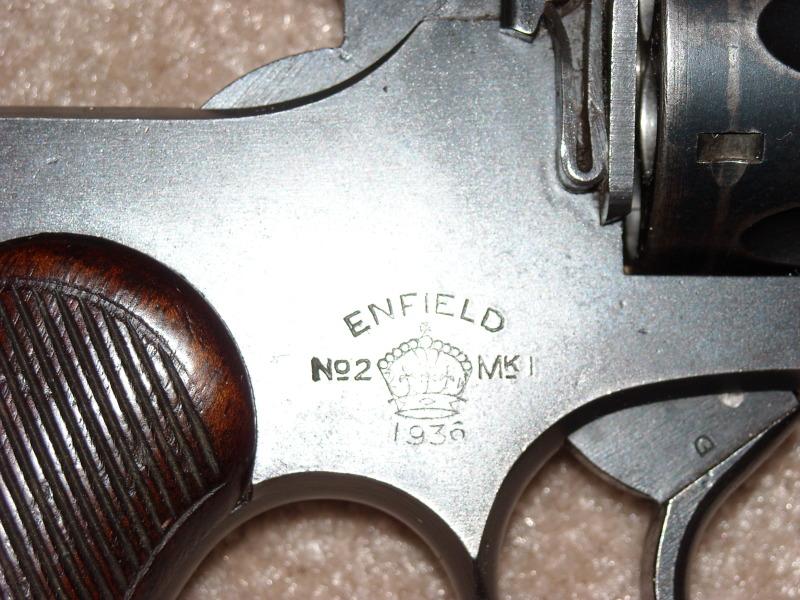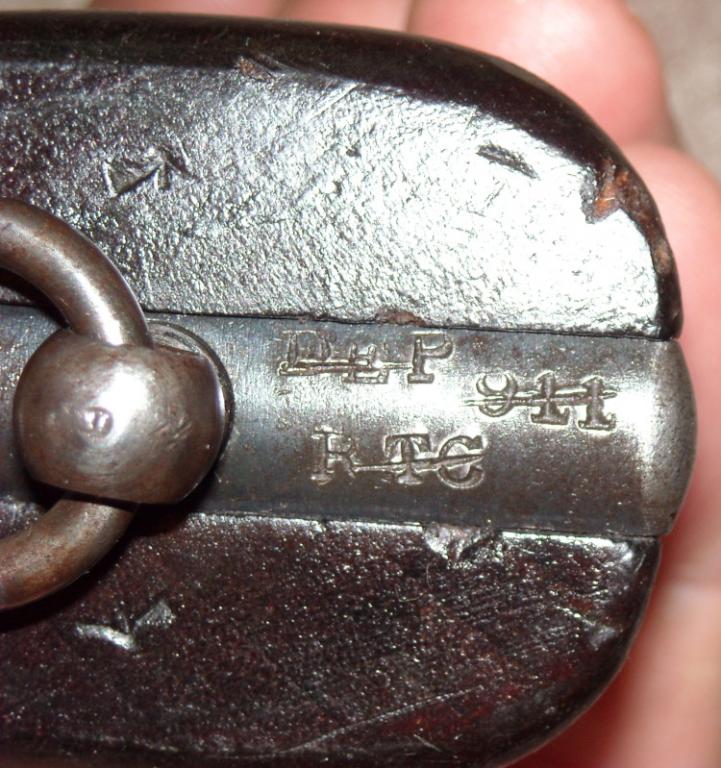-
Honest Sir... we didn't steal Webley's design... it's circumstantial!
So I picked up this lovely little 1936 Enfield manufactured No.2MkI revolver marked to the Royal Tank Corps Depot at Bovington Camp, Dorset. Weapon No. 911. It's a cancelled marking, probably because between 1936 and 1938 the Corps was renamed the Royal Tank Regiment, decentralized from Dorset, and expended to 51 battalions to go fight Hitler.
Lovely little piece really with better than 90% finish and it's never been rebuilt, refurbed, or even ham-fistedly disassembled. Wonder how it braved the war with so little wear in evidence (?).
As you may know, there is a fair bit of controversy around the Enfield No.2MkI. The basic story is that RSAF Enfield basically STOLE the Webley design and made the Enfield No.2MkI revolver - very nearly an outright clone of the Webley. Nevertheless, Enfield could not supply these in enough quantity during the war so a large quantity of real Webleys also had to be purchased.
Rather than type it all out, here is the Wikipedia take on those events, primarily excerpted from Ian Skennerton 's book on the No.2 revolver.
's book on the No.2 revolver.
Webley & Scott immediately tendered the .38/200 calibre Webley Mk IV revolver, which as well as being nearly identical in appearance to the .455 calibre Mk VI revolver (albeit scaled down for the smaller cartridge), was based on their .38 calibre Webley Mk III pistol, designed for the police and civilian markets. Much to their surprise, the
British
Government took the design to the Royal Small Arms Factory at Enfield Lock, which came up with a revolver that was externally very similar looking to the .38/200 calibre Webley Mk IV , but was internally different enough that no parts from the Webley could be used in the Enfield and vice-versa. The Enfield-designed pistol was quickly accepted under the designation Revolver, No. 2 Mk I, and was adopted in 1932, followed in 1938 by the Mk I* (spurless hammer, double action only), and finally the Mk I** (simplified for wartime production) in 1942.
Webley & Scott sued the British Government over the incident, claiming £2250 as "costs involved in the research and design" of the revolver. This was contested by RSAF Enfield, which quite firmly stated that the Enfield No. 2 Mk I was designed by Captain Boys (the Assistant Superintendent of Design, later of Boys Anti-Tank Rifle fame) with assistance from Webley & Scott, and not the other way around. Accordingly, their claim was denied. By way of compensation, the Royal Commission on Awards to Inventors eventually awarded Webley & Scott £1250 for their work.




And a side-by-each:

Information
 |
Warning: This is a relatively older thread
This discussion is older than 360 days. Some information contained in it may no longer be current. |
|
Союз нерушимый республик свободных Сплотила навеки Великая Русь. Да здравствует созданный волей народов Единый, могучий Советский Союз!
-
-
11-29-2011 07:24 PM
# ADS
Friends and Sponsors

-
FREE MEMBER
NO Posting or PM's Allowed

Anyone with any knowledge of firearms mechanisms would immediately ascertain the salient difference between the internal mechanism of the Webley Mark IV and the Enfield No.2 Mark I series revolvers. Captain Boys borrowed the best features of the proven revolver mechanisms of the era to produce a revolver distinctly different from the Webley produced handguns. The removeable sideplate was a great bonus as it allowed the mechanism to be easily repaired and adjusted for function without recourse to the arcane skills of a master pistolsmith-- someone few military establishments can afford to employ in peacetime or can find enough of during the exigencies of wartime. The British armed services ended up with, arguably, one of the most rugged and reliable handguns issued in WWII as a result of Captain Boy's efforts.
armed services ended up with, arguably, one of the most rugged and reliable handguns issued in WWII as a result of Captain Boy's efforts.
What exactly did Webley&Scott believe there was to be gained by their lawsuit, except sour grapes? Every other critical feature related to mechanical function of the Enfield revolver was no longer protected by any applicable patents viz ejection system, topbreak design or barrel latch. Once you removed these features from the equation and ally this with the entirely new internal mechanism, you realize just as the English courts rightly ascertained in their decision, that Webley& Scott really had no legal foundation for their case at all except for some nominal expenses the firm incurred during the period of cooperation with Captain Boys in their unrealized hope of retaining their status as sole single source manufacturer of service handguns for the British military. Hard cheese for Webley&Scott but there you have it.
In conclusion, if indeed Webley had provided the inspiration for Captain Boy's design and knew of its undeniable qualitative improvement over their products, why did they not sieze upon the design wholeheartedly and market an updated handgun design for the commercial marketplace? Would it not seem logical for them to have grabbed ahold of such a design and marketed it aggressively on a worldwide basis? Sadly, Webley continued manufacturing revolvers demanding expert handfitting and adjustment during manufacture, and so lacking in interchangeability of components that their revolver components had to serial numbered to the individual weapon, the bane of all armorers since time immemorial. It was a true corporate failure on the part of the management of Webley&Scott, who seemed to have remained myopically focussed on their previous glory and preeminence gained in the 19th century losing sight in the process of the undeniable fact the world was swiftly moving away from exactly the sort of fossilized Victorian era industrial mindset which inevitably consigned the firm to history's dustbin and a lamentable obituary in the history of firearms .
My two cent's worth.
Jerald Stamps
co-author of the ".380 Enfield No.2 Revolver"
Last edited by barbarossa; 11-29-2011 at 10:58 PM.
-
-
Deceased January 15th, 2016

I do agree with the comments above.
The problem is the British Government, via RSAF has previous and later. For example trying to avoid paying Sterling for the SMGs made at Fazackerly. The dog actually earned its bad name.
Government, via RSAF has previous and later. For example trying to avoid paying Sterling for the SMGs made at Fazackerly. The dog actually earned its bad name.
-
The difference was that Sterling sued the Government and won damages plus substantial costs. They also asked for and got further undertakings about sales of Fazakerley guns and future production of spares. Both were subsequently overlooked............
-
-
In my view, the single biggest infringement by Enfield was their copying of the manufacturing philosophy. I do not believe it's accidental that both guns make the same parts out of rolled plate. I also believe the mechanism was changed on purpose to try and avoid patent infringement. This in itself means Enfield was worried about the shades of grey they were operating under.
Союз нерушимый республик свободных Сплотила навеки Великая Русь. Да здравствует созданный волей народов Единый, могучий Советский Союз!
-
-
FREE MEMBER
NO Posting or PM's Allowed

Claven2, no matter what motivated RSAF, the Enfield still has a completely different internal mechanism and is thus a serious technical upgrade when compared to the Webley revolver. Manufacturing techniques are a worldwide phenomena especially when viewed in the context of economy and ease of manufacture and are no single firm's intellectual property. I personally believe Captain Boy's design of the internal mechanism is a piece of sheer brilliance--it is a shame no manufacturers have really invested any capital into upgrading the Enfield internal mechanism in the years since. It's about as rugged a design as can be made and is considerably better than most. And that includes the products of America's premier handgun makers Colt, Ruger and Smith&Wesson. In my experience, it is a significantly easier design to adjust during final fitting up than either the Colt or S&W revolvers. And it's hell for strong--I've seen countless Colt, S&W and Webley handguns in need of some serious adjustment to their internal mechanisms but damn few Enfields requiring same. It's simply a better design pure and simple.
Ya know, you only need a single screwdriver and a punch to completely disassemble an Enfield revolver to a pile of parts in a matter of minutes. Now, examine your Webley Mark IV--you need a couple of different screwdrivers, at least two punches plus a hammer to knock out the pins holding various parts of the trigger mechanism in place. Those little pins are tight. And if the revolver is in need of adjustment to the mechanism, well, you're working 'blind' inside a Webley. Small wonder the Brits did not adopt the Webley Mark IV design until wartime conditions forced their hand and mandated their purchase!
Last edited by barbarossa; 11-30-2011 at 12:38 PM.
-
I don't disagree that the Enfield improved on the Webley. I just think it was a bit disingenuous of Enfield to start with a Webly, make it better, then claim no part of their revolver was copied from the former. In some cases they changed the diameter of pins un-necessarily just so they could claim it wasn't interchangeable. This type of activity, to me, screms thatthey knew they were treading on IP rights and were trying to set themselves up for a court victory.
This is reflected in the court's decision which awarded partial damages to Webley and Scott as the paper records at Enfield showed WS had input on the design, despite Enfield's claims to the contrary.
Союз нерушимый республик свободных Сплотила навеки Великая Русь. Да здравствует созданный волей народов Единый, могучий Советский Союз!
-
-
FREE MEMBER
NO Posting or PM's Allowed

Claven2, no one denies the Webley revolver was the seminal inspiration for Captain Boy's design. And it is beyond dispute Webley&Scott DID indeed provide some input into the finalized design. Obviously, it was input of a rather insignificant nature, at least as far as the court was concerned, judging by the extremely nominal nature of the court's award to Webley in the way of damages. Once again, I must stress that none of the features which make a Webley revolver a Webley revolver were protected by patents--it was ALL in the public domain. As far as your contention RSAF Enfield changed components just enough so they would not share any interchangeability with the Webley antecedent, which exact component are you talking about? As far as I can ascertain from my own fairly lengthy hands on experience, about the only parts which indeed share interchangeability with the Webley is the lanyard ring assembly and the associated pin. NO other single component is similar in its final configuration be that cylinder, frame, barrel, hammer, barrel latch, sights or cylinder cam between the two designs. We won't even bother with the internal parts as they are COMPLETELY different in function and appearance when compared to any extant Webley product of similar or later provenance. So, I cannot with clear conscience concur with your well intentioned though misguided defense of the Webley firm's legal position anent Captain Boy's design. It is tantamount to Colt suddenly deciding since S&W or Ruger or whoever has marketed a revolver with a swing out cylinder, that firm's product has somehow been pirated from a Colt design, simply because it uses an nonpatentable public domain mechanical feature reminiscent of Colt's product.
Best Wishes
Jerald Stamps
Last edited by barbarossa; 11-30-2011 at 09:51 PM.
-
I have no doubt whatever that Boys/Enfield took their inspiration from Webley, albeit an old design that they improved on. But in doing so JUST skirted around any IPR or patent questions........... On the other hand, the Government were not in the least averse to trampling on others at the time, regardless of the IPR/Patent issues. As I learned during production engineering phase, that you can't patent the laws of physics or what we call 'the bleedin obvious' They copied outright the Mk6 Webley and made it at Enfield with no regard to patent rights or, well....., even permission. To say nothing of Sterling.
But just to thow one low baller into the ring chaps......... The notion that you could repair an Enfield revolver by just fitting new bits or...... or........... Nope. It was still a craftsmans weapon from the days of hand fitting. And someone who could do them was well respected. Others, like me, who blundered their way through revolvers were stuck with them! But Enfield No2's were tough old birds and I liked them.
-
's book on the No.2 revolver.
Government took the design to the Royal Small Arms Factory at Enfield Lock, which came up with a revolver that was externally very similar looking to the .38/200 calibre Webley Mk IV , but was internally different enough that no parts from the Webley could be used in the Enfield and vice-versa. The Enfield-designed pistol was quickly accepted under the designation Revolver, No. 2 Mk I, and was adopted in 1932, followed in 1938 by the Mk I* (spurless hammer, double action only), and finally the Mk I** (simplified for wartime production) in 1942.
 Information
Information





















 PM
PM








